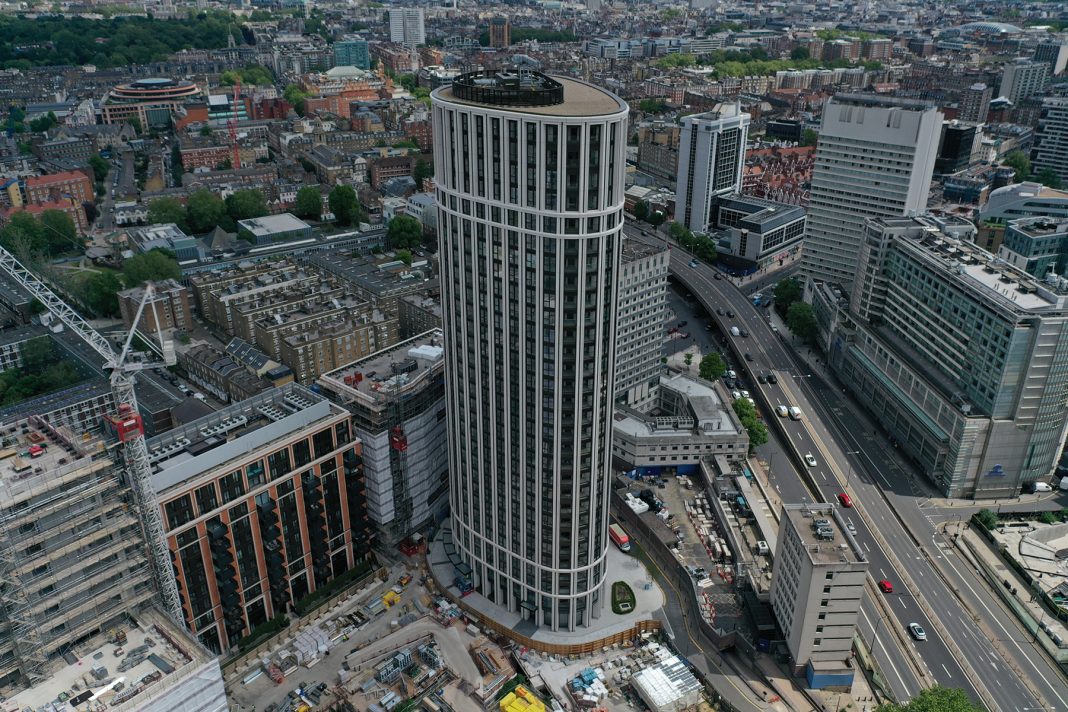Westmark Tower, a 110m, 29-storey curved on plan residential tower, in Marylebone, features over 14,000m2 of unitised curtain wall, designed and supplied by AluK and installed by envelope contractors Martifer.
All contributors agree however that what made the project really stand out was the collaborative approach demonstrated by AluK and the other consultants from the outset, which effectively de-risked the process for both the client and the contractor at pre-tender stage.
AluK worked with the lead architect Squire & Partners, delivery architect Design Delivery Unit (DDU), façade consultants Cladtech Associates and structural engineers WSP on a RIBA 4 system design for the unitised envelope.
Steven Watkins, the manufacturer’s Head of Projects, explained: “AluK’s specialist expertise meant that we could create a unitised façade solution for the post-tensioned concrete frame which easily satisfied the design intent, while making sensible savings on metal and accessory costs.
“As well as accelerating the design of the structural frame, this approach saved Berkeley many months compared to the normal procurement route and meant that the tender returns for the fabrication and installation of the façade were accurate and comparable. It saved the tenderers the normal costs associated with a bid and ensured that all the commercial and design iteration took place pre-bid and was not left to interpretation.”
AluK added that the challenge was to work with DDU to deliver a design that was true to the architect’s original intent, whilst addressing the technical issues of a curved on plan façade from the second to 29th floor. All the united cells needed to be dead loaded back to a post tensioned concrete frame with a 3-dimensional floor bracket, whilst catering for the varying facets of the façade.
The final unitised solution features more than 2,200 unitised cells of three principal configurations. Each floor comprises: a vision cell, typically housing AluK’s concealed vent and full height glass panes, a panel cell, specifically designed to house specialist internal framework to carry articulated GRC (Glass Reinforced Concrete) feature piers and spandrels, and a recessed balcony cell with an integrated floating glass balustrade.
With 36 different angles to overcome in a faceted design ranging from 0° to 15°, AluK developed a series of common aluminium extrusions to close the joints and reduce the number of profiles required. The horizontal stack joint uses an aluminium profile to carry the gasket and avoid the incidence of crimping as the cells are stacked around the building structure. What is also significant is that every cell connection provides four lines of system seal to ensure that the façade meets the stringent Cladtech performance specification and the CWCT Sequence B test.
From the onset of the project, the Berkeley director team set out a time and design model of early engagement, specialist designers and fabricators all within a clear programme. This also included a series of productive workshops sharing client expectations and considerations. AluK not only facilitated these meetings but also bought into the collaborative ethos and contributed to a highly successful project for Berkeley.
The façade design meets the thermal efficiency requirements of the building at 0.95W/m2K, as a weighted average. Using a 43dB Rw(+Ctr) acoustic glass, it also meets the sound reduction targets.
Tim Gledstone from Squire & Partners added: “Working together early in the design process allowed the design intent to be generated out of the crafted AluK products and industry latest processes. We could celebrate the best of the systems and push their potential to the optimum limits. The AluK design team were exceptional; dynamic and supportive throughout.”












